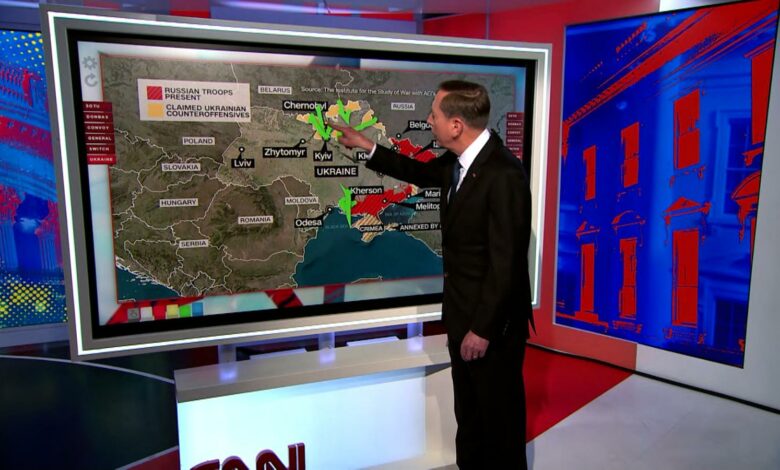
(CNN) – Western leaders are grappling with how far to escalate their military aid to Ukraine as the Russian invasion seems headed for a brutal new turn, a decision that may rest on whether the West’s goal is to push for a total defeat of President Vladimir Putin.
Heroic resistance from Ukrainian troops, with the help of Western anti-tank and anti-aircraft missiles, has already claimed a famous victory — the saving of Kyiv and the government of President Volodymyr Zelensky. But now, Russia has named a new general to lead what has been a chaotic war effort and is grouping its forces in eastern Ukraine for a fearsome, concentrated assault that could stretch Ukraine’s outnumbered forces as never before.
The shift of strategy is forcing Western leaders to consider their own willingness to provide more offensive armaments to Kyiv ahead of what is shaping up to be a vicious battle that could dictate how much of Ukraine survives as a nation-state.
Pressure on the West to do more is being exacerbated by the fact that Russia’s new approach augurs yet more carnage for the civilians that it has been deliberately targeting with a vicious war plan.
As Washington evaluates how to respond to Russia’s latest maneuvers, there were sighs of relief in the US capital as French President Emmanuel Macron prevailed in the first round of the presidential election. But the survival in office of a key member of the Western leadership coalition will only be assured if he can beat the runner-up, far-right candidate Marine Le Pen — a long-time Putin sympathizer — in the tight campaign that will play out ahead of the second round in two weeks.
New questions for the West about how best to bolster Ukraine’s resistance follow a skittishness in Washington earlier in the war about antagonizing Putin with, for example, the transfer of Soviet-era jets from NATO states like Poland to Ukraine. More recently, the US has signaled it is willing to help its partners to get Soviet-era tanks to Ukraine. And Britain promised a robust package of arms following Prime Minister Boris Johnson’s dramatic visit to Kyiv on Saturday.
Decisions on exactly what kind of weapons to provide could depend on the end game the West sees in the country, especially after Zelensky’s increasingly caustic appeals for more offensive weaponry following the discovery of atrocities against Ukrainian civilians when Russian forces pulled back from Kyiv.
President Joe Biden’s national security adviser Jake Sullivan gave the impression on CNN’s “State of the Union” on Sunday that Washington’s policy would follow Kyiv’s lead. But he also implied that broader US assistance and unprecedented sanctions on Russia’s economy were also designed to better position Ukraine for any future ceasefire talks — despite the failure of such efforts so far, given that there is little sign Putin is serious about a de-escalation.
“This is not a story of anyone standing by,” Sullivan told CNN’s Jake Tapper. “We are taking aggressive action in an effort to both help the Ukrainians succeed on the battlefield and help the Ukrainians have the best possible position at the negotiating table.”
But Republican Rep. Liz Cheney gave voice to a faction in Washington that says the US should be doing far more, though the Wyoming congresswoman is not advocating the dispatch of US troops to Ukraine. Western leaders have been concerned about igniting direct conflict with Russia amid fears of a nuclear escalation.
“We should not be talking about, as Jake Sullivan did just now, improving Zelensky’s position at the negotiating table,” Cheney said, also on CNN’s “State of the Union.”
“This is about defeating Russian forces in Ukraine. It’s about much more than Ukraine,” Cheney said, calling for shipments of tanks, artillery and armored equipment to be sent to the country. “We need to be doing much more, more quickly.”
Russia digs in for escalation in eastern Ukraine
CNN reported over the weekend that Putin has, for the first time, put a single military officer in charge of the Ukraine invasion, which has so far been plagued by poor strategy, supply issues, indiscipline and low morale among the troops.
The appointment of Army Gen. Alexander Dvornikov, the commander of Russia’s Southern Military District, has raised alarm in Washington.
White House press secretary Jen Psaki warned that Dvornikov was responsible for “atrocities we saw in Syria” and pledged that the US will continue to work to ensure Ukraine has the weapons it needs.
Washington has been walking a line between providing Ukraine with hardware that would allow it to repel the Russian invasion and inflict a heavy cost on Putin’s troops and being seen to take steps that would turn the war into a direct clash between the United States and Russia, which could cause a dangerous escalation.
But there are clear signs now that the West is reevaluating where those red lines are as the war enters a new stage.
The process comes as the world reels with revulsion from atrocities against civilians in the Kyiv suburb of Bucha and from an attack on a train station in the eastern city of in Kramatorsk that refugees were using to flee the fighting in eastern Ukraine.
Cheney said on CNN that the attack “clearly is genocide.” US and Western officials have stopped short of using that designation, citing the need for a legal process on a term that is typically used with specificity, but have frequently accused Putin and his troops of committing war crimes.
Both Psaki and Sullivan mentioned a two-hour call that took place between senior US military and administration appointees with top Ukrainian officials last week. During that call, the Ukrainians went down a list, item by item, of hardware and armaments that they’ve requested. Psaki said that the administration was working to ensure that if the US couldn’t provide the requested material, its allies could.
Johnson, for instance, laid out a package of equipment that the UK was willing to provide, including 120 armored vehicles and new anti-ship missile systems.
It was not clear what limits that Washington might place on the criteria of weaponry that might be available to the Ukrainians.




